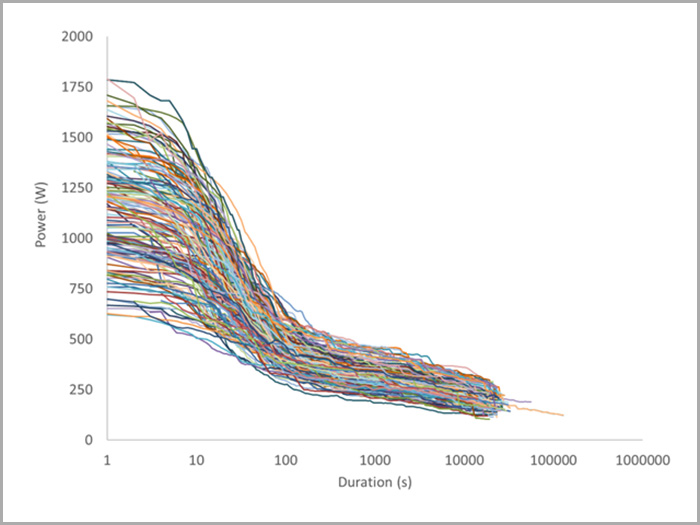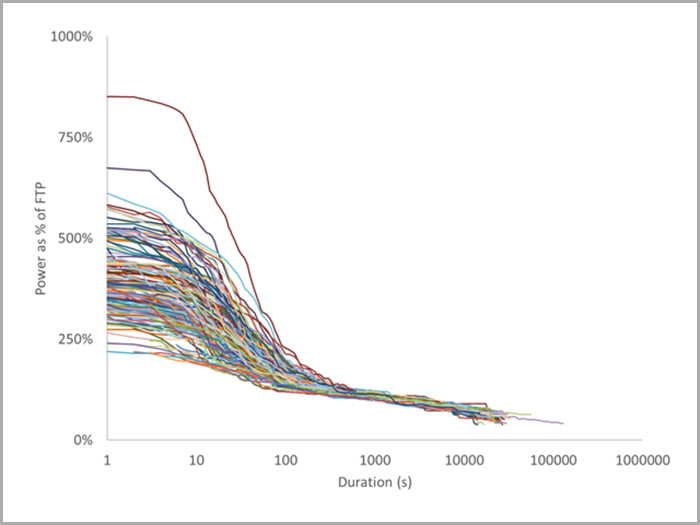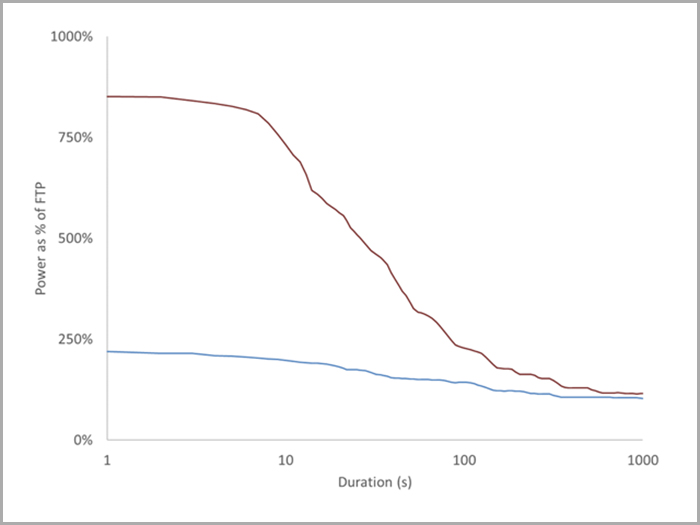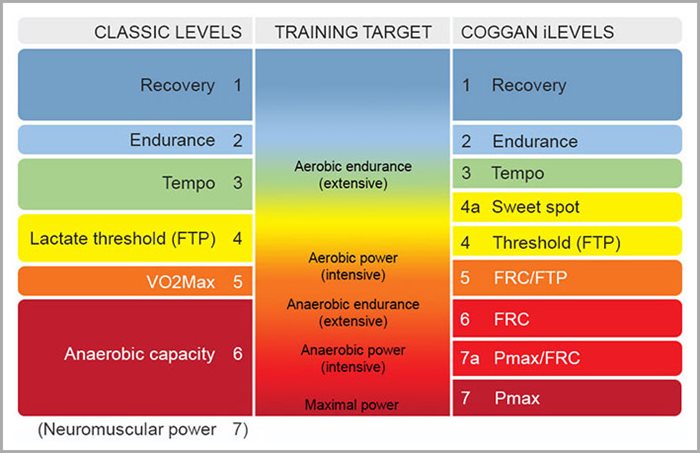One of the most important features of WKO4 is a robust and extensively validated mathematical model of the power-duration relationship. The new Power Duration Curve provides the foundation for a number of other analytical tools unique to WKO4. For example, the model enables automatic tracking of changes in fitness via the Power Duration Metrics History Chart, objective assessment of an individual’s inherent strengths and weaknesses via auto-phenotyping, and more. The purpose of this article is to describe the rationale for and basis of yet another novel application of the model: the determination of highly-individualized training levels (iLevels) for describing and prescribing training.
The Advantages and Limitations of Classic Training Levels
In 2001, I introduced a systematic approach1 for categorizing training sessions based on measurement of an athlete’s power output1. This system has gained widespread popularity among amateur cyclists and has been adopted by various national governing bodies, not only in cycling but in other sports as well. It utilizes an anchor-point approach, in which the five lowest training levels are defined relative to what are termed Functional Threshold Power (FTP). FTP is a performance-based (functional) surrogate marker of an individual’s muscular metabolic fitness, i.e, his or her Lactate Threshold (LT), as the term is used conceptually by exercise physiologists.
This is logical since metabolic responses to exercise such as glucose uptake and oxidation are more closely related to LT than to cardiovascular fitness, i.e., to maximal O2 uptake (VO2max)2. Consequently, endurance performance is highly correlated with power (or pace) at LT, even in athletes with comparable values for VO2max3. Expressing training levels as a percentage of FTP therefore essentially places everyone on the same scale, thereby greatly minimizing intra-individual differences in metabolic responses and hence in the stimulus for adaptation.
The validity of this original approach for defining power-based training levels is supported by the data shown in Figures 1 and 2 below, which are drawn from the database of nearly 200 seasoned athletes used to develop the WKO4 model. Specifically, when expressed in absolute terms in watts, there is tremendous inter-individual variability in the power-duration relationship, reflecting in part the widely-varying abilities of the athletes in question.
However, when expressed in relative terms as a percentage of FTP, such variation is greatly minimized, at least at all durations beyond the first few minutes of exercise. Even the results from the ultra-marathon mountain bike specialist, whose mean maximal power curve extends beyond those of the other cyclists to approximately 35 hours, falls directly in line with the trend established at shorter durations by the other athletes.
This data clearly demonstrates that there are only limited differences between individuals in their sustainable power output once differences in FTP are taken into account. Again, this is due to the key role that metabolic fitness plays in determining endurance performance ability, as well as the validity of FTP as a surrogate marker of this important physiological characteristic.
Figure 1.

Figure 2.

Although it is logical to define power-based training levels relative to FTP for predominantly aerobic intensities, this does not make sense at higher intensities and shorter durations of exercise, where factors other than metabolic fitness are the primary determinants of performance. Because of this, in the original system I created, level 6 (Anaerobic Capacity) is defined as simply being higher than level 5, whereas level 7 (Neuromuscular Power) is not linked to FTP at all. While appropriate and correct, these definitions are of somewhat limited use for prescribing the power outputs and durations of intervals intended to increase, such as sprinting ability or resistance to fatigue during very high intensity, unsustainable exercise.
Consider, for example, the two athletes in Figure 1 with the highest and lowest maximal power relative to FTP, respectively (World Champions in their respective disciplines of the match sprint and time trial). As shown in Figure 3 below, their relative power was generally similar at durations more than about 10 minutes. However, there is obviously a very large (approximately fourfold) difference in the extent to which they can elevate their power above FTP at very short durations. As a result, the one athlete can maintain a power of, for example, 150 percent of FTP for about 4 minutes, while the other athlete can do so for only about one minute. Clearly such large inter-individual differences in performance during short-duration, high-intensity (supra-FTP) exercise preclude the use of any sort of one-size-fits-all, anchor-based approach.
Figure 3.

iLevels as a Solution
As stated in the introductory paragraph, one of the benefits of WKO4’s power-duration model is the ability to cogently define more highly-individualized training levels. Based on the logic behind the original approach, levels 1-4 remain anchored to FTP, with the addition of a new level 4a (SweetSpot) at 88-94 percent of FTP to satisfy the requests of numerous coaches who have found value in prescribing workouts at this intensity.
However, at higher intensities, four levels (instead of three) have been defined, with the boundaries between them determined based on specific identifying features/characteristics of the individual’s model-derived mean maximal power curve, reflective of the individual’s unique physiology. The approximate relationship between the original training levels and the new iLevels, both conceptually and with respect to terminology, is shown in Figure 4. Since the new iLevels are based on the shape of an individual’s power duration curve, the exact relationship between the two systems will obviously vary, at least at the higher levels.
Figure 4.

Practical Use of iLevels in Coaching and Training
Now that you know about why iLevels were created, let’s talk about training. What exactly is training? Training is the completion of specific activities meant to evoke an adaptation response in the body. To evoke this adaptation, we need to apply an overload, and the overload must be specific to the desired physiological improvement. At its core, training is the application of a “dose” in the effort to achieve a desired “response.”
Why do we need training levels? Training at different intensities brings about different physiological adaptations. The goal of specific training levels is to allow you to control and measure how hard you ride, which gives you the ability to target specific improvements in your fitness. Training levels are used to quantify and track intensity, put simply, to prescribe and describe workouts.
How many training levels do we need? When I introduced the Classic Coggan Training Levels, I stated at the time, “Since the physiological responses to exercise really fall on a continuum, with one intensity domain simply blending into the next, a compromise must therefore be made between defining more zones, thus better reflecting this fact, and defining fewer zones for the sake of simplicity. In the present system, seven zones were felt to be the minimum needed to represent the full range of physiological responses and to adequately describe the different types of training required/used to meet the demands of competitive cycling.”
Given that the classic system was based on Functional Threshold Power (FTP), the seven zones made sense. At that time, the benefit of being more specific was not worth the cost of increased complexity. Based on the data I had, the cost-benefit ratio of more specificity just wasn’t large enough.
So why more training levels now? With the introduction of the new Power Duration Model and the ability to accurately estimate the entire power-duration relationship, the cost-benefit relationship has changed; the benefit of training zones individualization significantly outweighs the cost of the increase in intensity. Although coaches and athletes will need to invest some time in learning about iLevels, the improved results of totally individualizing your training will be worth it. There are three main benefits of iLevels:
- The ability to individualize your training levels
- Specificity in the relationship between time and intensity
- Improved tracking of specific training results
Individualizing Your Training
This topic has been well covered in the article linked above, but it’s important to at least summarize here. The principle of individuality4 dictates that the decisions concerning the nature of training should be made with each individual athlete in mind. Most current systems of deducing training levels are based on some form of threshold or FTP. These systems help initialize your training by establishing your threshold as the baseline, but they fall short in the individualization of the actual training zones (particularly above threshold), as such zones are based on percentages (using threshold or FTP as 100%) and assume that all training athletes generally fall within those zones.
With the introduction of iLevels, we are able to move beyond this classic paradigm and base all above-threshold/FTP training on each individual’s unique physiology as exhibited in the Power Duration Model. This allows for significant improvements in the dose and response of training; we can now prescribe more accurate training and track more specific results.
Specificity in the Relationship Between Time and Intensity
Using iLevels to enhance the dose-and-response relationship of training is about increasing the specificity of such training for each unique individual athlete. In 2008, I addressed the relationship between time and intensity in introducing the Coggan Classic zones. At that time I wrote, “There is obviously an inverse relationship between power output and the duration that power can be sustained. Thus it is axiomatic that power during shorter training sessions or efforts will fall toward the higher end of a given range, whereas power during longer sessions or efforts will fall toward the lower end of a given range.”
The percentage-based system lacked the ability to delineate the relationship between the time and intensity, particularly at and above threshold/FTP, needed to elicit a specific response, and it left the coach/athlete to determine the time and intensity prescription based on a broad range in each training level. The implied theory was, as I stated, axiomatic.
The introduction of the nine iLevels not only individualizes the answer but further defines the relationship between time and intensity at training levels at and above threshold/FTP. Historically, training prescription for workouts above threshold/FTP were based on the following paradigm:
- Build endurance at a certain training level by prescribing power targets at the lower end of the training level for time periods at the longer end of the time continuum to build endurance at such level.
- Build power at a certain training level by prescribing power targets at the higher end of the training level for time periods at the shorter end of the time continuum to build power at such level.
I refer to this as extensive or intensive intervals. Utilizing the Coggan Classic Levels, a coach or athlete would use the general training zones to make broad decisions on the difference between intensive and extensive training doses in the effort to create a desired response. With the new iLevels, not only can we now individualize the power targets, but we can also individualize the time relationship for each target.

Improved Tracking of Specific Training Results
At the end of the day, training is all about results. The introduction of the new Power Duration Model allows for two significant improvements in this area. First, it is based on all performances by the athlete and reflects current fitness and performance. This means that micro changes in fitness are immediately integrated into the training level system.
In the past, when utilizing the Coggan Classic Levels, the coach or athlete needed to use formal testing (or intuition) to determine changes in FTP and correlating changes in training levels. Since the Power Duration Model is based on all of an athlete’s data, it updates (potentially) with each file uploaded. Second, it allows for the tracking of specific changes in fitness. The old system tested and tracked one to four key, time-based performances to approximate specific fitness (classic testing of 5 seconds, 1 minute, 5 minutes, 20 minutes) and required such testing to determine whether improvement was demonstrated in a specific performance or physiological zone. Since the Power Duration Curve updates with each file, you can track changes in the curve shape over time.
Take a look at the example below. You can see this athlete has had little change in threshold/FTP in the last 90 days when compared against year-to-date, but he has had significant improvement in shorter, anaerobic ability. In the classic system, this is hard to recognize without formal testing, and even with formal testing, it is limited to a select few time ranges. The Power Duration Model, however, allows for the viewing of all time points.
Since this athlete uses iLevels, the training targets updated as this change occurred, ensuring continued overload of the correct intensity. This is a superior way to track the dose-response relationship in training.
In summary, the new iLevels system based on the Power Duration Curve dramatically increases the individuality and specificity of training and gives the coach/athlete a tool to create more efficient and effective training programs.
WKO4 Product Manager Tim Cusick contributed to this article.
Download a free 14 day trial of WKO4 and join the WKO4 Facebook Group.
References
- Coggan, A.R. et al. (1992, November). Plasma glucose kinetics during exercise in subjects with high and low lactate thresholds. Retrieved from https://pubmed.ncbi.nlm.nih.gov/1474063/
- Coyle, E.F. et al. (1988, June). Determinants of endurance in well-trained cyclists. Retrieved from https://pubmed.ncbi.nlm.nih.gov/3403447/
- Rushall, B.S. & Pyke, F.S. (1990). Training for sports and fitness. Melbourne, Australia: Macmillan. (pp. 84-95). Retrieved from https://coachsci.sdsu.edu/csa/vol34/rushall3.htm

